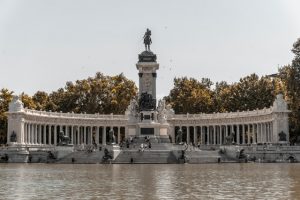There are too many sights in Madrid alone to see and experience in a weekend. Here are some of the must-see sights in Madrid that are not far from each other and can fit into your weekend getaway.
One of Europe’s most visited cities, the Spanish capital receives about 7 million tourists a year, and is one of the cities with the fastest population increase.
How to arrive
The city of Madrid is accessible by car, plane and train from anywhere in Spain.
By car
Spain has six radial highways that all begin and end in Madrid and are numbered accordingly.
- A1 – Madrid to Burgos
- A2 – Madrid to Zaragoza
- A3 – Madrid to Valencia
- A4 – Madrid to Cordoba, Sevilla and Cadiz
- A5 – Madrid to Badajoz and Portugal
- A6 – Madrid to La Coruna
By plane
Madrid has one international airport – the Adolfo Suarez Madrid Barajas Airport. From here, Iberia, the Spanish flag carrier airline flies to many international destinations. However, there are several budget airlines that also fly in and out of the Barajas airport.
- Vueling – from Barcelona, Ibiza, and Menorca
- Ryanair – from Almeria, Asturias, Bilbao, Girona, Gran Canaria, Ibiza, Lanzarote, Menorca and Santander
- Easyjet – from Bilbao, Ibiza, La Coruna and Menorca
By train
Spain boasts of the longest High-Speed Rail (HSR) network in Europe with 3,622 kms that connects to many cities across Spain. This high-speed AVE (Alta Velocidad Espana) travels at a speed of 310 km/hr and operates from both the Chamartin and Atocha stations.
Madrid in a weekend

The best place to start is from the Parque del Buen Retiro, one of the largest parks in Madrid that was built in the 17th century as the gardens of King Felipe IV’s Palacio de Buen Retiro.
From the Retiro, one can proceed to the Calle Alcala, that is really one long avenue that leads all the way to the Barajas Airport. But it is on this route where some of Madrid’s must-see places are located. The Puerta de Alcala that was commissioned by Carlos III and designed by his architect Francesco Sabatini sits in the middle of the Plaza de Independencia. The king liked both of Sabatini’s designs, could not make up his mind as to which he liked best and ordered that both designs be used, one on each side of the neo-classical gate. A turn around the Plaza de Independencia brings one to the magnificent fountain of Cibeles or Cybele, the goddess of fertility, healer and protector in time of war that was designed by Ventura Rodriguez. Behind the fountain, is the grand Palacio de Cibeles. From the fountain of Cibeles, one proceeds to the Gran Via.
Construction of the Gran Via began only in 1910 and was finished in 1929. From this grand boulevard, many small streets branch out to reveal many historical buildings mostly decorated with large statues. On the Gran Via, one can find many shops, restaurants, bars and theaters. From the Gran Via, one proceeds to the Puerta del Sol.
The Puerta del Sol is where the symbols of Madrid proudly stand – a statue of a bear leaning on the arbutus tree. It is here too where kilometer 0 begins and from where all the streets in Madrid radiate from.
The Plaza de Oriente and the Palacio Real de Madrid, one of the largest palaces in the world, cannot be missed. From the Plaza de Oriente, one can proceed to the Catedral de la Almudena at the edge of the city.
What to eat when in Madrid
A typical breakfast in Madrid is chocolate con churros at the Churreria La Mejor although there are many other churrerias spread across the city. One must also try the cocido Madrileño, a traditional chickpea (garbanzos) – based stew with meat and vegetables or the callos (tripe) Madrileña, a stewed tripe dish at Casa Carola. For heartier meat dishes, there is the cordero al horno or baked lamb at Asador de Aranda or meat cooked on stones at El Buey. If this is all too much, a simple but delicious bocadillo de calamares can be had at La Campana.
Museums and flea markets
One cannot leave Madrid without a visit to at least one of its many museums. The Golden Triangle of Art is the most convenient with three excellent museums walking distance from each other.
The Museo Nacional del Prado is the main national art museum and is located near the Parque de Retiro. It houses one of the world’s finest collections of European art from the 12th to the 20th century particularly paintings of important Spanish artists like Francisco Goya and Diego Velasquez.
Museo Nacional Centro de Arte Reina Sofia is Spain’s national museum of 20th century art. It was inaugurated in 1990 and houses the work of Spain’s greatest 20th century masters, Pablo Picasso and Salvador Dali. The most famous masterpiece of the museum is Picasso’s painting Guernica.
The third member of Madrid’s Golden Triangle of Art is the Museo Nacional Thyssen-Bornemisza. It is housed in the Palace of Villahermosa and the core of its collection is made up of the extensive art collection of Heinrich, Baron Thyssen Bornemisza de Kaszon.
Lastly, one can happily end their weekend visit to Madrid with time spent at El Rastro de Madrid. El Rastro is a large open air flea market in Madrid’s La Latina neighborhood. It is held every Sunday and on public holidays and is where a great variety of products like ceramics, leather goods, vintage books, home décor including antique furniture, clothes, works of art and some much more, both used and new can be found at bargain prices.
